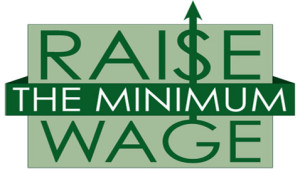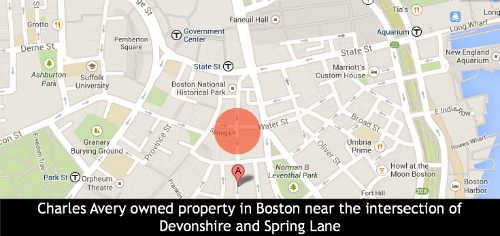Last night, Zingerman’s co-founder Paul Saginaw and I met up for a late dinner at Dalat to discuss the various campaigns being waged across the country right now to raise the minimum wage, and how it came to pass that he’s become a spokesman for the movement. My hope is to share my notes later in the week, once I’ve had a chance to transcribe everything. In the meantime, though, I wanted to share a little background on the minimum wage, in hopes that it might better inform our conversations between now and November, when it’s likely to be on the Michigan ballot.
HERE ARE THE PRESENT FACTS AS I UNDERSTAND THEM:
• $7.25: The present hourly minimum wage as set by federal law.
• $10.74: How much the federal minimum wage would be if it had kept up with inflation over the past 40 years. [note: This does not take into account the significant gains in productivity made by American workers over the last several decades.]
• $15,080: The annual income for a full-time employee working the entire year at the federal minimum wage.
• $7.40: The Michigan minimum wage.
• 50%: Percentage of workers making minimum wage, or less, who are over 25 years of age. [note: There are instances where workers can be paid below the minimum wage. The federal minimum for tipped labor, for instance, is $2.13 per hour, as long as the hourly wage and tip income, when taken together, equal at least minimum wage. Also, employers are allowed to pay workers below the age of 20 $4.25 an hour for their first 90 days of employment.]
• 34%: Minimum wage workers with an associates degree or some college experience.
• 3.3 million: The number of people working for wages at, or below minimum wage in the United States. [note: In 2013, 1.5 million were reported as earning exactly minimum wage. During that same time, approximately 1.8 million were reported as earning wages below the minimum wage. Together, this 3.3 million represents 1.0% of the population, 1.6% of the labor force, 2.5% of all workers, and 4.3% of hourly workers respectively.]
CURRENT INITIATIVES UNDERWAY TO RAISE THE MINIMUM WAGE:
 While organized labor has been working on the issue for some time – most recently helping fast food workers in several U.S. cities to launch campaigns – the issue of raising the minimum wage really began to gain national traction in January of last year, when Barack Obama noted in his annual State of the Union address his desire to see the federal rate raised from $7.25 to $10.10. “To every mayor, governor, and state legislator in America, I say, you don’t have to wait for Congress to act; Americans will support you if you take this on,” said the President. “And as a chief executive, I intend to lead by example. Profitable corporations like Costco see higher wages as the smart way to boost productivity and reduce turnover. We should too. In the coming weeks, I will issue an Executive Order requiring federal contractors to pay their federally-funded employees a fair wage of at least $10.10 an hour – because if you cook our troops’ meals or wash their dishes, you shouldn’t have to live in poverty.” [The White House press release on the President’s statement can be found here.]
While organized labor has been working on the issue for some time – most recently helping fast food workers in several U.S. cities to launch campaigns – the issue of raising the minimum wage really began to gain national traction in January of last year, when Barack Obama noted in his annual State of the Union address his desire to see the federal rate raised from $7.25 to $10.10. “To every mayor, governor, and state legislator in America, I say, you don’t have to wait for Congress to act; Americans will support you if you take this on,” said the President. “And as a chief executive, I intend to lead by example. Profitable corporations like Costco see higher wages as the smart way to boost productivity and reduce turnover. We should too. In the coming weeks, I will issue an Executive Order requiring federal contractors to pay their federally-funded employees a fair wage of at least $10.10 an hour – because if you cook our troops’ meals or wash their dishes, you shouldn’t have to live in poverty.” [The White House press release on the President’s statement can be found here.]
As Obama mentioned elsewhere in the speech, there is presently a bill in the Senate that would, if enacted, raise the federal minimum wage to $10.10 for all workers, and not just the employees of federal contractors. Most folks who watch Congress seem to agree that, given the current state of affairs in Washington, it doesn’t have a chance of passing, but the legislation – Tom Harkin’s Fair Minimum Wage Act of 2013 – is scheduled to come up for a vote this week. As the President noted, though, no one is holding their breath, waiting for Congress to do the right thing. No, the battle is shifting to the states, where the odds of making a positive change are significantly better. The following summary of the current situation comes by way of the New York Times.
…But the (federal) stalemate matters less and less. In the last 14 months, since Mr. Obama first called for the wage increase in his 2013 State of the Union address, seven states and the District of Columbia have raised their own minimum wages, and 34 states have begun legislative debates on the matter. Activists in an additional eight states are pursuing ballot referendums this year to demand an increase in wages for their lowest-paid workers.
The result is an outside-the-Beltway variation on Mr. Obama’s pledge to use his executive powers to bypass an obstructionist Republican Party in Congress. In this case, White House aides said they believed that Mr. Obama’s feverish rhetorical push for a higher minimum federal wage, to $10.10 per hour from $7.25, has helped generate political pressure on states to act…
The state minimum-wage actions, which have created a patchwork of minimum wages across the country, are not the uniform step that Mr. Obama and his allies would prefer. Some states have minimum wages on the books that are below the current federal level of $7.25 an hour, meaning that the federal level automatically applies to them. Other states already require wages to start at $8, $8.25 or higher. The District of Columbia, which already has an $8.25 per hour minimum wage, could have the highest in the nation on July 1, 2016, when it rises to $11.25.
But Mr. Obama’s advisers have embraced the legislative flurry across the country as a second-best alternative that can work politically and substantively. Local increases in the minimum wage will help workers and pump money into those economies, they say…
THE MICHIGAN INITIATIVES:
Here in Michigan, there are two such efforts underway. In the Michigan House of Representatives, Adam Zemke and Jeff Irwin have co-sponsored Michigan House Bill 4386, which would increase the state minimum wage from $7.40 to $9 this year. And, at the same time, a coalition of various civil rights, faith, labor and community organizations is trying to get the issue on the November ballot, so that the voters of Michigan can weigh in. The group, called Raise Michigan, needs to collect 258,088 valid signatures from registered voters by May 28. If passed, the Raise Michigan legislation would 1) raise the minimum wage from $7.40 to $10.10 an hour by January of 2017, 2) Ensure the minimum wage keeps up with the cost of living, based on the Consumer Price Index, and 3) Guarantee that eventually tipped workers, like waiters and waitresses, earn the full minimum wage. (Tipped workers in Michigan, who are currently paid $2.65 an hour, would receive an $.85 an hour increase each year until they’re paid the full minimum wage.)
While I expect that Republicans in Lansing will kill the legislation being put forward by Irwin and Zemke, I suspect that the Raise Michigan ballot initiative has a better than 50% chance of passing… I’d like to say that it would be a slam dunk, given that the idea seems to have widespread support from voters right now, but you can be sure, if it does make it on the ballot, that the Koch brothers and their fellow Plutocrats will be pouring an ungodly amount of money into the state, in hopes of convincing Michiganders to once again vote against their own best interests. And, as we know from experience, they’re damn good at what they do.
ENERGIZING THE BASE IN A NON-PRESIDENTIAL ELECTION YEAR:
It’s also worth noting that this isn’t just about the minimum wage. This is also about motivating the Democratic base to get out and vote in a non-Presidential election. And that, to a large extent, explains why we’re seeing so many progressives across the country looking to get the minimum wage on the November ballot in their states. It’s just like, a few years back, when a lot of conservative groups were coming together to get anti-gay marriage ballot initiatives in place… This isn’t to say that Obama and the Republicans don’t care about the minimum wage. I think they recognize that it’s an important thing to do, if for no other reason that to temporarily stabilize our society, which is in danger of losing the middle class altogether, as the gap between the rich and the poor continues to grow. I do think, however, that this is a godsend for the likes of Mark Schauer, who hasn’t exactly been lighting a fire under Michigan Democrats. And we’re not alone in that regard. All over the country, there are state-wide races where the minimum wage could really make a difference by bringing people to the polls, where they might also vote out Republican governors and legislators.
As I mentioned above, everyone knows that, at least for the time being, nothing is going to happen in Washington. No, if we want to make progress on issues like education, the environment, and civil rights, it’s going to have to be at the state level. And, in order to do that, we need to start winning races closer to home… Hopefully, the minimum wage will help us do that.
$10.10 AN HOUR WILL RAISE FAMILIES OUT OF POVERTY AND PUT MORE MONEY INTO THE ECONOMY:
Raising the minimum wage to $10.10 would give more than 27 million workers a raise, which, in turn, will put more money into the economy. Here, with more on those 27 million people, are a few facts from Senator Tom Harkin.
• 88% are adults over the age of twenty, 55% are women, and nearly half are workers of color.
• More than 14 million children have a parent who would get a raise.
• The average affected worker brings home approximately 50% of her household’s income.
• 71% of tipped workers getting raises would be women – a key step for women’s pay equity.
If you still want more, I’d encourage you to check out this report from the Economic Policy Institute, which lays out the benefits to the economy which would be realized with a minimum wage of $10.10. Here’s a clip.
…(R)aising the minimum wage would provide immediate benefits not only to affected workers (whose incomes would rise), but to the broader economy as well. Research over the past two decades has shown that, despite skeptics’ claims, modest increases in the minimum wage have little to no negative impact on jobs (Schmitt 2013). In fact, under current labor market conditions, where tepid consumer demand is a major factor holding businesses back from expanding their payrolls, raising the minimum wage can provide a catalyst for new hiring.
Economists generally agree that low-wage workers are more likely than any other income group to spend any additional earnings they receive, largely because they must in order to meet their basic needs. Higher-income individuals, corporations, and beneficiaries of corporate profits are more likely to save at least a portion of any additional income. Thus, in a period of depressed consumer demand, raising the minimum wage can provide a modest boost to overall economic activity because it shifts income to workers who are very likely to spend it immediately. Indeed, recent research from the Federal Reserve Bank of Chicago finds that raising the federal minimum wage to $10 could increase U.S. GDP by up to 0.3 percentage points in the near term (Aaronson and French 2013).
Our research shows that raising the federal minimum wage to $10.10 by 2016 would provide an additional $35 billion in wages over the phase-in period to directly and indirectly affected workers, who are likely to then spend that additional income. This projected rise in consumer spending would provide a modest boost to U.S. GDP, even after accounting for the increased labor cost to businesses and the potential for small price increases for consumers. Using standard fiscal multipliers, we would expect that increasing the federal minimum wage from $7.25 to $10.10 would generate a net increase in economic activity of $22.1 billion over the phase-in period. This additional GDP would support roughly 85,000 new jobs…
Also, to those who would say that prices would rise as a result, I’d encourage you to read this recent report by a Bloomberg analyst which showed that raising the minimum wage at Walmart to $10.10 would translate to the addition of just one cent to the price of a $16 item, assuming all additional costs were passed on to consumers.
OK, that’s everything that I know… What do you know?
[And stay tuned for that interview with Paul Saginaw. I think you’ll like it.]

















